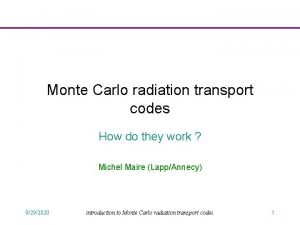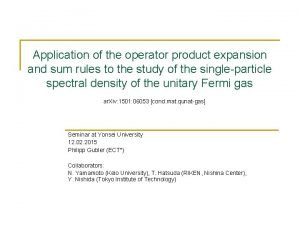MONTE CARLO EVENT GENERATION IN A 406 MULTILANGUAGE


- Slides: 2

MONTE CARLO EVENT GENERATION IN A 406 MULTILANGUAGE, MULTIPLATFORM ENVIRONMENT Norman Graf Tony Johnson Stanford Linear Accelerator Center Abstract: We discuss techniques used to access legacy event generators from modern simulation environments. Coding to a standard interface and use of shared object libraries enables runtime selection of generators, and allows for extension of the suite of available generators without having to rewrite core code. International Linear Collider (ILC) Designed to exploit the physics discovery potential of e+ e- collisions at s ~ 1 Te. V. Interfacing Legacy Event Generators üMost generators can target the HEPEVT common block. üstdhep provides a binary persistence binding Will perform precision measurements of complex final states and require: ûstdhep not well supported on all platforms, somewhat tricky to implement for casual users. v. Exceptional momentum resolution v. Excellent vertexing capabilities v“Particle Flow” calorimetry v. Hermeticity v. Could interface with generators simply through persistent output: FORTRAN program stdhep file user app. Require access to many different event generators to fully investigate interplay of machine, physics and detectors. ûDisk storage can be prohibitive in large statistics fast-simulation physics analyses. ûEnd users need to know idiosyncrasies of each package, i. e. no standard main programs or runtime input commands. Problem Statement v Physics and detector simulations for the International Linear Collider are being conducted by an amorphous and heterogeneous group of high energy physicists, working mostly part-time on this project. v Simulation software needs to be lightweight, yet flexible and performant over a wide variety of development platforms. v. HEP community has mostly completed it transition to modern, object-oriented programming languages such as C++ and Java e. g. GEANT 4, ROOT, JAS, … One exception is event generators. Most event generators producing unweighted events with stable final state particles appropriate for detector response simulations are either written in FIRTRAN or depend on FORTRAN-based libraries for fragmentation, e. g PYTHIA, ISAJET, HERWIG pandora-pythia v Alternative is to abstract out a common generation interface and provide standard implementations. A pure Java Solution v. Providing a simulation and reconstruction framework written in Java has proven to be well matched to this environment. ü Object Oriented and easy to use. ü Many support libraries. ü Platform independent. û Few event generators are written in Java! üDo have a “diagnostic” generator for simple events. A Multilanguage Solution v. Use Java to provide a consistent platformindependent interface. v. Use Java Native Interface (JNI) to call FORTRAN event generators via C++. v. Use shared-object (. so) or dynamic link library to delay binding and provide runtime felxibility.

406 Encapsulation Philosophy is to push as much as possible onto the native event generators. Control is through ASCII files which are parsed by FORTRAN routines. These communicate with the COMMON blocks in the event generator code to set parameters. Can select processes, beamstrahlung, decay channels, etc. at run-time by editing text file. Output is stdhep files Runtime Control üInteract natively with event generators ISAJET has well-defined set of control “cards” Input file same as for FORTRAN job. PYTHIA has command-parsing capability Simply pass these commands to PYGIVE HERWIG has neither abstract out a “reasonable” set of parameters. Java calls C++ class through JNI with minimal interface: public native void initialize(); public native void next. Event( int[] nev, int[] isthep, int[] idhep, int[] jmohep, int[] jdahep, double[] phep, double[] vhep); public native void finish(); C++ communicates with FORTRAN: extern "C" void initialize_(); extern "C" void nextevent_(); extern "C" void finish_(); typedef struct // HEPEVT common block { int nevhep; // event number int nhep; // number of entries int isthep[4000]; // status code int idhep[4000]; // PDG particle id int jmohep[4000][2]; // pos’n of 1 st, 2 nd mother int jdahep[4000][2]; // pos’n of 1 st, last daughter double phep[4000][5]; // 4 -mom, mass double vhep[4000][4]; // vertex position & time } hepevtcommon; üFORTRAN code simply fills HEPEVT common block for each event. ûThis code has to be written by someone with expertise in the generator, but then can be used by anyone. • Control is through initialize_ call, and is generatorspecific. Similarly for other generators ûNeeds input from an “expert” in the generator. üInteraction from Java/C++ is only through initialize() method. üAll. dll or. so libraries respect same interface, so can dynamically select and load at runtime >java Evt. Gen lib. To. Load üCatalog of available generators can be expanded in the future, without users having to modify any of their existing code. Simply distribute new. so or. dll! import hep. analysis. Event. Generator; import hep. analysis. Event. Data; import hep. analysis. End. Of. Data. Exception; import hep. io. stdhep. adapter. Stdhep. Adapter; /** * LCD interface to stdhep event generators. * @author Norman Graf */ public class Stdhep. Event. Generator extends Event. Generator { Stdhep. Adapter _stdadapter; private Evt. Gen _eventgen; /** * Constructor loads native library */ public Stdhep. Event. Generator(String generator. Name) { _stdadapter = new Stdhep. Adapter(); System. load. Library(generator. Name+"evtgen"); _eventgen = new Evt. Gen(); // Constructor calls initialize() } /** * Generate a single event */ public Event. Data generate. Event() throws End. Of. Data. Exception { _eventgen. next. Event(); return _stdadapter. convert(_eventgen. Stdhep. Event()); } /** * Finish up */ public void after. Last. Event() { _eventgen. finish(); } } Summary v. Use of Java as the user interface and JNI to connect to legacy code has proven to be a useful solution. v. Definition of a minimal interface allows generators to be selected at runtime without code modification and allows smooth future upgrades.



